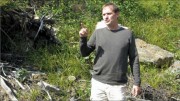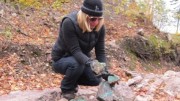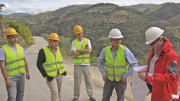A handful of Arizona-focused copper juniors are making steady progress delineating resources and fine-tuning potential development plans towards feeding an independent, Western supply chain.
Near the semi-desert town of Casa Grande, Ariz., Arizona Sonoran Copper (TSX: ASCU; US-OTC: ASCUF) is outlining a scalable redevelopment of its brownfields Cactus mine project. The company is working to expand mineralization at Cactus, and is working to expand on the base case preliminary economic assessment (PEA), in a re-scoped prefeasibility study (PFS) which will include P/S along with the Cactus, economics for the first time.
While several high-profile copper projects in Aexrizona have been stalled by myriad permitting issues, Cactus’s brownfields status and its location on private lands should make for streamlined and known permitting timelines.
“Arizona has a mining pedigree,” project director Dan Johnson tells The Northern Miner during an invited February site visit, while pointing towards notable features in the Arizona desert that constitute the former mining operation or where the new developments will occur. He adds that permitting would not involve the federally mandated Environmental Protection Agency.
The U.S. Army Corps of Engineers has already confirmed there is no ‘Clean Water Rule’ applicable on-site and therefore no federal permitting requirement.
VP for exploration Douglas Bowden says the company is currently looking to build scale.
To get there, the company is working on upgrading inferred resources at the Parks Salyer deposit with a 46-hole, 32,000-metre drill program at Cactus, located 64 km southeast of Phoenix. So far, 35 infill holes for 23,689 metres have been completed.
On Feb. 21, Arizona Sonoran released assays from seven infill drill holes at Parks Salyer, which is located on contiguous land 2 km southwest of Cactus.
According to the company, the program continues to show the tenor of mineralization and has extended the high-grade zones in the north and south. Drilling has initially been staged to infill areas closest to the inferred high-grade core before expanding out toward the west.
Additionally, the company has completed three hydrology holes at Parks Salyer consisting of one oriented core hole and two previously drilled metallurgical holes. The hydrology holes will collect groundwater data near the Parks Salyer deposit.
The company has all the data in hand for the Cactus deposit, and will be includedthe pending PFS.
Bowden says in addition to drilling, the company is undertaking, metallurgy, detailed engineering, permitting and technical studies.
It has also been busy building the onsite operations and technical team.
Arizona Sonoran targets oxide and enriched copper mineralization. It plans to complete an additional 27,000 metres of infill drilling at the Cactus East and Parks Salyer projects by the year’s second half.
This year’s work will inform a feasibility scheduled for release in 2024. Arizona Sonoran will also begin a small exploration program by June along the 4,000-metre mine trend from the Cactus to Parks Salyer deposits, which comprise the Gap Zone and NE Extension deposits. Previous drilling at the NE Extension by ASARCO highlighted mineralization down to 305 metres depth at a grade of 3% copper over 11.3 metres.
Metallurgy
Meanwhile, the company is advancing metallurgical studies for oxide and sulphide material. Testing programs for the prefeasibility and feasibility studies include columns of material from the existing stockpile, Parks Salyer and Cactus deposits, separated into different rock types, copper grades and mineralogy. The program will feed into the PFS.
In addition, Rio Tinto is testing the leachability of the primary sulphide material at Cactus and Parks Salyer with its Nuton technology.

Dan Johnson inspecting the column metallurgical tests currently underway on site. Credit: Henry Lazenby.
The sulphide component in the indicated and inferred resource contains 1.7 billion lb. of copper and did not factor in the PEA. If the preliminary test results from Rio Tinto, expected by the second half, are positive, and pending finalizing a commercial agreement with Rio, Arizona Sonoran would have the ability to process lower-grade sulphide material and monetize a large portion of the resource that the company currently considers “stranded.”
The miner may also do infill drilling on the primary sulphide material at Cactus, related to Nuton’s technological requirements.
Combining the oxide and sulphide components would make Cactus and Parks Salyer the third-largest independent (not owned by a major) copper resource in the U.S., totalling 4.9 billion lb. inferred and 1.6 billion lb. indicated.
Fully cashed-up with a recent $30 million financing, the company expects to complete a mine plan and PFS by December or early in 2024, which will include Parks Salyer for the first time in an economic assessment and a more comprehensive underground development program than in the PEA. The PFS will lead to a definitive feasibility study at the end of 2024, followed by a construction decision and financing in 2025. If construction starts by mid-2025, production from the stockpile could begin by late 2026.
District scale potential
Just across the highway from the Cactus mine is Ivanhoe Electric’s (TSX: IE) Santa Cruz copper project, which has a slightly larger resource and has attracted much more market attention due to the Robert Friedland premium — the mining magnate is the company’s executive chairman and was previously CEO.
On Feb. 14, the company published an updated mineral resource estimate for Santa Cruz, which now includes the first resource for the East Ridge deposit directly next to the Santa Cruz deposit and for the Texaco deposit 1.6 km to the northeast.
This resource update is underpinned by much higher cut-off grades than the 0.39% used in the December 2021 resource statement to account for the consistency and thickness of the higher-grade exotic, oxide and enriched copper domains.
The resource at the Santa Cruz deposit reflects a 0.7% total copper cut-off, while the resources at East Ridge and Texaco reflect a 0.9% and 0.8% total copper cut-off, respectively.
Even at these higher cut-off grades, the overall project-wide contained copper in indicated resources increased by 11% to 2.8 million tonnes (226.7 million tonnes grading 1.24% total copper). Importantly, contained copper in indicated resources, excluding primary sulphide mineralization, increased by 86%.
It wouldn’t take a lot of imagination to see the potential future consolidation of the Cactus-Parks Salyer and Santa Cruz projects. The combined volumes could ostensibly make an expensive mill facility viable. At the same time, other synergies could be achieved concerning leaching the oxide material and a central SX-EW cathode production facility.
Faraday Copper
Further to the southeast from Casa Grande, Faraday Copper (TSX: FDY; US-OTC: CPPKF) is focused on growing its Copper Creek project near San Manuel in Pinal County, and aims to release a PEA in April.
The company’s VP for projects and evaluations, Zack Allwright, told The Northern Miner on a February site visit that Copper Creek is one of the most significant undeveloped copper porphyry projects in the Americas.
The project sat stranded for the past decade, until CopperBank Resources acquired it in 2018. Company president and CEO Paul Harbidge and CFO Graham Richardson then evaluated the asset and proposed to the prior management to take over CopperBank. Richardson came in as a CFO after that.
A rapid work program followed. “That’s why the project is only now becoming known to the market again,” he said.
VP for exploration Thomas Bissig said the company’s recent exploration efforts generate stronger confidence for resource growth.
Copper Creek has a combined open pit and underground measured and indicated resource of 355.1 million tonnes grading 0.5% copper 3.9 billion lb. copper with molybdenum and silver credits, for 4,125.3 million lb. copper equivalent. The resource estimate is supported by more than 200,000 metres of drilling.
The resource estimate used metal price assumptions of US$3.80 per lb. copper, US$13 per lb. molybdenum, and US$20 per oz. silver.
The most recent assay results reported on Jan. 31 highlighted 33.77 metres at 3.43% copper and 2.53 grams silver per tonne from 38.1 metres at the Copper Knight breccia in drill hole FCD-22-016. This interval is within a longer intersection of 65.2 metres at 1.88% copper and 1.56 grams silver per tonne from 38.1 metres depth.
Bissig explained that the Copper Knight breccia is part of a cluster of mineralized breccias, which includes Copper Giant, Copper Prince, and Copper Duchess. Drill hole FCD-22-016 was collared north of Copper Knight and drilled to the southeast, closing a gap in historical drilling.
The high-grade mineralization is located at the contact between granodiorite porphyry and hydrothermal breccia, with increased permeability.
In addition, drill hole FCD-22-011 was collared at the Glory Hole breccia and drilled to the west, where previous drill coverage is low. Two consecutive samples from 63.36 to 67.70 metres yielded 0.29% and 0.41% copper, respectively, and a single 2-metre-wide sample with 1.14 grams silver per tonne and 0.21% copper is present at 210.75 metres. These results suggest that the mineral system remains open at depth and to the west of the Glory Hole breccia, Bissig said.
Weighing development options
Fourteen drill holes have been completed, and the results for three drill holes have been released.
Bissig said results so far from the phase two drill program have been encouraging. “This high-grade drill hole demonstrates the potential to grow the open pit mineralization at Copper Creek,” he said.
Phase two drilling continues the 41 sq.-km land package and is focused on reconnaissance drilling on new targets; expanding the resource estimate; and better delineating high-grade mineralized zones.

Faraday Copper’s Copper Creek project hosts multiple breccia and porphyry copper deposits. Credit: Henry Lazenby.
The upcoming PEA will incorporate an updated resource. But the company believes the project has much larger district potential, with only 35 out of 400 breccias identified to date drill tested.
In terms of permitting, Allwright points out the project waterways are deemed impaired under state law since they sit on top of copper porphyries, which naturally leach chemicals. This means there is no agricultural competition, and the water is marked for industrial use.
Bissig said the PEA would outline a sulphide play for a starter scenario – the oxide material will be stockpiled since the acid needed for leaching is too expensive for the foreseeable future.
The company recently closed a $40 million financing.
Ivanhoe Electric is the elephant in the room, with its shares up 50% over the past 12 months at $21.00 apiece, giving it a market cap of $2 billion. Arizona Sonoran shares are down 17% over the same period at $1.80, giving it a market cap of $187 million, while Faraday is down 15% at 75¢, with a market cap of $129.8 million.






Be the first to comment on "Site visit: Arizona juniors keen to shore up made-in-America copper supply"